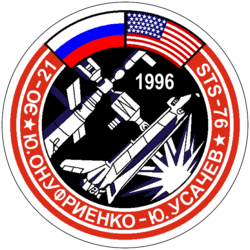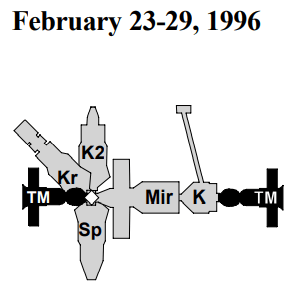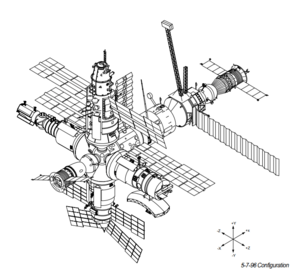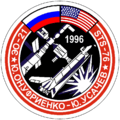Soyuz TM-23 facts for kids
| Operator | Rosaviakosmos |
|---|---|
| Mission duration | 193 days, 19 hours, 7 minutes, 35 seconds |
| Orbits completed | ~3,155 |
| Spacecraft properties | |
| Spacecraft | Soyuz TM-23 (7K-STM No. 72) |
| Spacecraft type | Soyuz-TM |
| Manufacturer | RKK Energia |
| Launch mass | 7,150 kilograms (15,760 lb) |
| Crew | |
| Crew size | 2 up 3 down |
| Members | Yuri Onufrienko Yury Usachov |
| Landing | Claudie André-Deshays |
| Callsign | Скиф (Skiph - Scythian) |
| Start of mission | |
| Launch date | February 21, 1996, 12:34:05 UTC |
| Rocket | Soyuz-U |
| Launch site | Baikonur Launch Pad 1 |
| End of mission | |
| Landing date | September 2, 1996, 07:41:40 UTC |
| Landing site | 50°17′N 70°50′E / 50.28°N 70.83°E |
| Orbital parameters | |
| Reference system | Geocentric |
| Regime | Low Earth |
| Perigee | 202 kilometres (126 mi) |
| Apogee | 240 kilometres (150 mi) |
| Inclination | 51.6 degrees |
| Docking with Mir | |
| Docking date | 23 February 1996, 14:20:35 UTC |
| Undocking date | 2 September 1996, 4:20:00 UTC |
| Time docked | 191.5 days |

Soyuz programme
(Crewed missions) |
|
The Soyuz TM-23 was a Soyuz space mission. It launched on February 21, 1996. Its goal was to fly to the Mir space station. The spacecraft took off from the Baikonur Cosmodrome. After two days, cosmonauts Yuri Onufrienko and Yury Usachov arrived at Mir. They became the 21st crew to live on the station. On September 2, 1996, after 191 days, the ship left Mir. The original crew and Claudie André-Deshays were on board. They landed safely in Kazakhstan.
Contents
- Meet the Crew
- Mir Expedition 21: Key Moments
- February 1996: A New Crew Arrives
- March 1996: Space Shuttle Atlantis Visits Mir
- First Spacewalk for Mir 21 Crew
- Space Shuttle Atlantis Takes Off
- Getting Ready to Dock
- Atlantis Approaches Mir
- Third Atlantis and Mir Docking
- Shannon Lucid Joins Mir 21
- New Supplies Arrive on Atlantis
- Experiment Equipment
- Work in the Spacehab Module
- Preparing for a Spacewalk
- SAFER Backpacks Used
- First U.S. Spacewalk at Mir
- Atlantis Leaves Mir
- April 1996: A New Module for Mir
- May 1996: Supplies and Spacewalks
- June 1996: More Spacewalks and Science
- July 1996: Greenhouse Work and a New U.S. Record
- August 1996: Supply Ships and New Arrivals
- September 1996: Mir 21 Crew Returns Home
- Images for kids
Meet the Crew
| Position | Launching crew | Landing crew |
|---|---|---|
| Commander | First spaceflight |
|
| Flight Engineer | Second spaceflight |
|
| Research Cosmonaut | None | First spaceflight |
Yuri Onufrienko and Yury Usachov were the main crew for this mission. They were joined by other astronauts during their time on Mir. Claudie André-Deshays returned to Earth with them.
Mir Expedition 21: Key Moments
The Mir 21 mission was full of important events. The crew welcomed new modules and visitors. They also performed many spacewalks and experiments.
February 1996: A New Crew Arrives
Soyuz TM-23 Launches and Docks
On February 21, the Soyuz TM-23 rocket launched. It carried the new crew for Mir Expedition 21. To make space, the Progress M-30 supply ship undocked. It then burned up safely over the Pacific Ocean.
The Soyuz TM-23 docked with Mir on February 23. The crew entered the station about 90 minutes later. They were greeted by the Mir 20 crew. This included Yuri Gidzenko, Sergei Avdeyev, and Thomas Reiter. For a week, the old crew showed the new crew around. They also fixed a small water leak in the station.
Mir 20 Crew Returns Home
On February 29, the Mir 20 crew left the station. They entered the Soyuz TM-22 spacecraft. They landed safely in Kazakhstan. Their mission lasted for 179 days. Thomas Reiter set a record for European astronauts.
March 1996: Space Shuttle Atlantis Visits Mir
First Spacewalk for Mir 21 Crew
On March 15, Yuri Onufrienko and Yury Usachov went on their first spacewalk. They installed a new Strela boom. This arm helped them reach different parts of Mir. They also prepared cables for a new solar array. This spacewalk lasted almost six hours.
Space Shuttle Atlantis Takes Off
The U.S. Space Shuttle Atlantis launched on March 22. It was its 16th flight, called STS-76. There was a small leak in one of its systems. But it stopped once Atlantis reached orbit. This did not affect the mission.
Getting Ready to Dock
For two days, the Atlantis crew flew towards Mir. They checked their equipment for docking. They also started experiments in the Spacehab module. Astronauts Linda Godwin and Michael Clifford prepared for their spacewalk.
Atlantis Approaches Mir
On the third day, Atlantis was close to Mir. The crew fired engines to get closer. Atlantis approached Mir from below. They used radar to track their speed and distance.
Third Atlantis and Mir Docking
On March 24, Atlantis docked with Mir. This made the space station complex very large. After checking for leaks, the hatches opened. The two crews greeted each other. They then set up air ducts between the ships.
Shannon Lucid Joins Mir 21
Shannon Lucid officially joined the Mir 21 crew on March 24. She was the first U.S. astronaut to stay on Mir for a long time. More U.S. astronauts would follow until 1998.
New Supplies Arrive on Atlantis
The crews moved over 1 ton of U.S. science gear to Mir. They also brought almost 2 tons of Russian supplies. About 1.5 tons of water were also transferred. They moved about 1 ton of waste from Mir to Atlantis. The crews also saw Comet Hyakutake from space. Atlantis brought new batteries and a seat for Shannon Lucid.
Experiment Equipment
New supplies included parts for glovebox experiments. There was also equipment to measure radio interference. An experiment to bond different metals was also brought up.
Work in the Spacehab Module
The crew worked on the Biorack in the Spacehab module. This module held eleven experiments. They studied how microgravity and cosmic radiation affect plants, animals, and bacteria. Scientists from many countries designed these experiments.
Preparing for a Spacewalk
Before the spacewalk, Atlantis's air pressure was lowered. The hatches between Mir and Atlantis were closed. The Mir crew stayed inside Mir. The Atlantis crew stayed in their ship.
SAFER Backpacks Used
Astronauts Godwin and Clifford wore special backpacks. These "Simplified Aid for EVA Rescue" (SAFER) packs had small jets. They could help an astronaut return to the spacecraft if they drifted away. This was a test of the SAFER backpack.
First U.S. Spacewalk at Mir
On March 27, Godwin and Clifford did a 6-hour spacewalk. They attached four experiment containers to Mir. These experiments, called MEEP, collected data on space debris. They also tested materials for the International Space Station. The astronauts also tested new tools for spacewalks. They retrieved a camera used for docking.
Atlantis Leaves Mir
On March 28, the crews said goodbye. Atlantis separated from Mir. The shuttle then flew around the station twice. The crews took pictures of each other's spacecraft.
April 1996: A New Module for Mir
Mir 21 Continues with Full Crew
The crew's daily schedule was planned in advance. NASA experts helped with science activities. They worked on the OLiPSE experiment, processing metal samples. They also did life science research and took Earth photos. Monitors were placed to record station movement. Radiation sensors measured the environment. A small leak was found in a coolant loop. It was turned off, and a backup was used.
The Priroda Module Arrives
The new Priroda module was launched on April 23. It was the last of Mir's main modules. It had a mass of 19,700 kg and was about 12 meters long. Priroda was designed for Earth observation. One of its power systems had a problem. But the main system worked perfectly.
Priroda docked with Mir on April 26. On April 27, the crew moved Priroda into its final spot. Mir now had all six of its main modules. This completed the station's main shape. The crew then entered Priroda. They removed and bagged 168 batteries. These would be disposed of later.
May 1996: Supplies and Spacewalks
Progress M-31 Brings New Supplies
A new Progress cargo ship launched on May 5. It docked with Mir on May 7. For the first time, all of Mir's main ports were full. The crew began unloading supplies. They also continued their science work. They replaced batteries in Priroda. A power controller failed, so ground control managed battery charging. The coolant leak was found, but it was not a danger.
New Solar Array Installed
On May 20, Onufrienko and Usachev went on a spacewalk. They moved a new solar array from its storage spot. They used the Strela boom to move it to the Kvant module. During this spacewalk, they also inflated a large Pepsi can model. This was for a TV commercial.
On May 25, they did another spacewalk. They finished installing the solar array on Kvant. Once connected, the array unfolded.
Mir 21 Crew Greets STS-77 Crew
The Mir 21 crew talked with the astronauts on Space Shuttle Endeavour (STS-77). They also held a press conference.
Camera Installed on Priroda
On May 30, Onufrienko and Usachev installed a German camera. It was called MOMS. This camera collected data about Earth's atmosphere. It had flown on two previous Shuttle missions. The cosmonauts also installed a new handrail. This would help with future spacewalks.
June 1996: More Spacewalks and Science
Experiments Installed During Fifth Spacewalk
On June 6, the crew did another spacewalk. They installed two U.S. science experiments. These were the Particle Impact Experiment and the Mir Sample Return Experiment. They also replaced a part in the Komza experiment.
Rapana Girder Assembled
On June 13, the cosmonauts spent over five hours outside Mir. They assembled a Rapana girder. This structure would hold future experiments. They also manually deployed a radar antenna on Priroda. The antenna had not opened fully on its own.
Science Work Continues
Shannon Lucid helped the cosmonauts from inside Mir. She also activated equipment for biotechnology studies. She conducted experiments on the human immune system. The crew took air samples and recorded spacecraft motion. They also evaluated the Microgravity Isolation Mount.
July 1996: Greenhouse Work and a New U.S. Record
Shuttle Docking Delayed
On July 12, NASA announced a delay for STS-79. This was the next Atlantis mission to Mir. It was postponed until mid-September. A problem was found with the shuttle's rocket boosters. Even though they were safe, they were replaced for extra safety.
U.S. Space Record Broken
On July 15, Shannon Lucid broke a record. She became the U.S. astronaut with the longest time in space. The previous record was 115 days. Her flight would be even longer due to the shuttle delay.
Greenhouse Work
The crew set up the Svet facility for a plant experiment. They planted dwarf wheat seeds. A power issue in Kristall caused a delay. But they fixed it by using an extension cord. They also replaced a part in the carbon dioxide removal system.
August 1996: Supply Ships and New Arrivals
Progress Ships Swap Places
On August 1, Progress M-31 left Mir. It burned up in Earth's atmosphere. A new supply ship, Progress M-32, arrived on August 2. It docked with Mir.
Gyrodynes Fixed
The Mir 21 crew began setting up experiments. They also fixed the gyrodyne system. This system helps control the station's position.
August Experiments
The first dwarf wheat seeds were planted in the Greenhouse. The crew observed Earth from space. Shannon Lucid continued her experiments. These included studying how alloys form in space. She also looked at how muscles work in microgravity. Other experiments studied flame spreading and measured radiation.
Mir 22 Crew Arrives
On August 17, Soyuz TM-24 launched with the new Mir 22 crew. To make space, Progress M-32 undocked on August 18. It waited in orbit. Soyuz TM-24 docked on August 19. The new crew included Commander Valery Korzun, Flight Engineer Alexander Kaleri, and Cosmonaut Researcher Claudie Andre-Deshays. Claudie Andre-Deshays was from the French Space Agency. She would return to Earth with the Mir 21 crew.
Cassiopee Mission Experiments
Claudie Andre-Deshays worked on many science projects. These included studies on the cardiovascular system. She also tested how the neurosensory system works in microgravity. Other experiments looked at embryonic development and fluid dynamics.
September 1996: Mir 21 Crew Returns Home
On September 2, Onufrienko, Usachev, and Andre-Deshays left Mir. They were in the Soyuz TM-23 spacecraft. They landed safely in Central Asia. Onufrienko and Usachev had been in space for 194 days. Andre-Deshays had been in space for 17 days.
Images for kids




